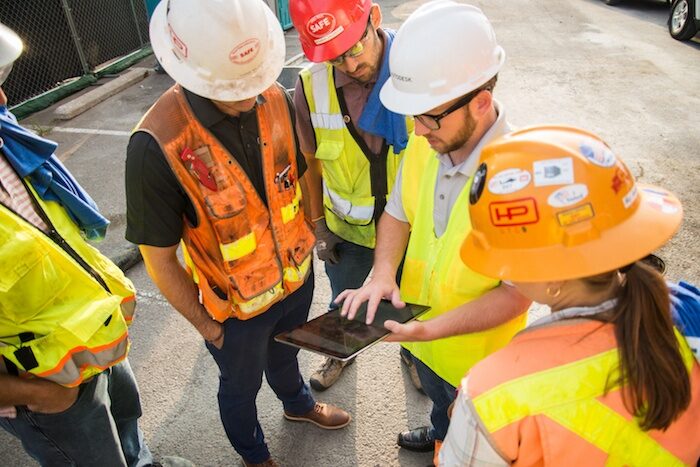
The picture above is telling. This is the new Gurugram city, a suburb of New Delhi, India. Nearly a 100% of the homes and apartments in this picture are new (under 5 year old concrete construction). Real Estate companies have built a city overnight in the middle of farmland here in the state of Haryana. The neighborhood around this picture on National Highway 8 is interesting for another reason - for the sheer volume of construction that is still going on. The numerous cranes, raw material and equipment that has been deployed to build future housing for what would be, by year 2030, the largest human population ever to live in a single country.
Imagine yourself to be a Project Manager in one of these real estate projects. The real estate company wants you to not only build, but build fast and build secure, comfortable homes which people will buy and be happy living in. The stakeholders have to kept satisfied, right? Most of the construction is debt-fueled and the faster the projects are delivered the better it is for everyone involved. In this article we focus on the learnings from such construction projects that is so valuable for Technology Project Managers. Classic civil engineering construction projects are inarguably very different from the modern day IT and industry projects. Nevertheless there are some common themes.
By definition a Project has a start and end. Else it would not qualify as a project. PMI institute's PMBOK guide has dozens of pages focused on "Stakeholders" and the "Monitoring and Controlling" aspects of projects. Stakeholders are crucial to construction work just as they are to tech projects. Similar to tech product or IT projects, these projects also not only have the line workers, managers, administration staff, investors and project managers (PMs) but also clients, regulatory bodies, sub contractors, suppliers and, often, community representatives and other stakeholders.
Human kind have been building large projects like bridges, roadways, rail and homes for centuries now. Project Management discipline has largely matured through these projects. There are some clear ways in which a Real Estate / Building a Home project is different from the majority of projects that are now undertaken in the developed world. However the essential elements of a project, a.k.a a time-bound initiative to produce a unique product or service hasn't changed. It is essential for young Tech PM's of this generation to learn from such age-old endeavors and from project management discipline, which itself has matured so much from large civil, mechanical and industrial engineering projects.
Let us focus on some important ways in which IT projects are remarkably different from the rest of the projects that human kind has attempted from pre-historic times to, say, 1984 when tech became mainstream. One huge difference is the physical nature of the end product. Building a widget or a gadget or a brick or a home - these all are items which you can hold in your hands, feel, weigh and literally see being built right in front of you. Contrast that with a project titled "Data Governance Optimization for Euro GDPR changes". Somewhat ephemeral, right? Modern industry and tech projects have made every effort to create things like KPIs, dashboards and reports or, in the social domain, things such as Likes and Re-Tweets to quantify the results of any project. Such metrics are close but anyone who has worked on a Data Governance project will tell you it is hardly the same as a physical thing. It is complicated when you have to decipher and first agree on things like "Definition of Done", in case of Agile method. Construction projects have no such problem - you can see what is being built and once it has progressed enough you can literally walk into it! Artificial Intelligence (AI) projects are a hot business these days. Mike Quindazzi from PWC states that "..by 2020, the AI market is projected to reach $70 billion, driven by increasing computational power and improving approaches/applications with machine, deep learning, natural language processing and robotics and many a number of other technologies".

Needless to say AI projects will require a lot of Project Managers to create these smart bots and machines. So how to effectively manage development projects in AI where what you are constructing - the end game - is itself fluid and changing? How do we determine the scope, schedule and budget of such projects? How do we manage these projects effectively? Project Management seems to have an answer.
What are some of the good project management practices which are transferable to any project effort irrespective of industry or domain? And more specifically how can modern tech PM's learn from classic projects. We have bucketed the answers to these questions into 4 areas. We call these principles of "Real World Project Management".
1. Drive for Timelines and Results but empower Project Workers - Saying that Project Management is about people is a cliche, but so very true. Any PM who is working on one of the gazillion Artificial Intelligence projects out there can tell you for a fact - you can make a machine smart but even to do that you first need tremendous dedication and performance from project personnel who are usually smarter than the PM. In Real World Project Management (RWPM) we call this a concept of 'Working Space' - to state simply, give people enough space to do their job. Whatever the skill is for which that person was hired for. We can all agree that appropriate checks and balances, performance metrics are hugely important for the success of all projects. However, do we want too much surveillance of someone who is tweaking genomes for that next great pharmaceutical R&D project? We already live in a surveillance society where nearly all our actions are recorded. Social media firms are trying to monetize every aspect of our communication. Per HBR recently - "Algorithms control what you read". Most projects have PMC tools where team members are required to input and sign off on task progress. In such an environment an increasing PM focus on completion percentages is misplaced. All Tech PM's need to ask themselves some basic questions. Have we given the project team members enough working space to do their job? At what point the basic metric collection by Project Manager become counterproductive?
In Real World Project Management once a PM has assigned a task, say assigned material movement to the operators, the PM's job then is the classic monitoring and controlling - making sure the deadline is met and the task is completed without issues. In other words the material has been safely moved. It would be unwise for the PM to take a super frequent status update from the line workers as such metadata collection (in data-speak) takes away important time from the job. All project teams need to agree upon and adhere to PM data collection cycle.
At all times PM's outreach and communications to the team continue to be critical. Terezinha (Bairos) Hignett, a client engagement manager has written about this on CoreWorx Project Blog. She writes - "To ensure governance, risk, and compliance processes are met, ‘enable and standardize project communication..'"
PMI President and CEO Mark A. Langley states “At every level of the organization, stakeholders should understand how projects and programs connect to the overall organization strategy, and be speaking a common language that facilitates collaboration and clearly identifies evolving expectations for project outcomes. Companies that cut corners on communications are unnecessarily incurring extra risk.”
2. Hire an Engaged Project Manager - Most leaders with 20+ years of experience in industry and business - think group VPs and Principal at Fortune 500 companies and enterprises - will tell you that the chances of misalignment in the PM role are generally very high. And this comes at a time when most <significant> transformative work in organizations, like AI, is being done and managed as a project for the obvious benefits - efficiency, impact and returns.
Some groups which have a weak organizational matrix have a tendency to render PM role sterile and all authority resides with the operational managers. In some cases operations staff, in fact, becomes openly hostile to PM's and Projects. Engaged PM's continue to reinvent themselves and develop and deploy tactical skills to combat such organizational challenges as hostility to the project itself.
Eric Simms, PMP, (an experienced PM with US Census Bureau) recommends an approach to dealing with a hostile environment where the PM shows people he or she has their best interest in mind and then makes project management conform the organization (and not the other way around). Richard Hawk from Deloitte writes on employee engagement in general but that applies to Project Managers as well. He says - "If you hire someone who shares the passion for your company’s product or service, you will have an engaged employee that excels often".
Nevertheless this becomes tricky as PM's are frequently tasked to run projects of varying functional and business areas. In Real World Project Management, we always and always hire an engaged PM who can speak across the different functional domains, manage expectations, drive for project execution efficiency and command an organization-wide focus on project end-results.

3. Tie Project Work to Organizational Vision and Mission: Project Manager Blog has a mantra around aligning project to overall strategy. It is - "Review Every Project". They explain - "Strategic alignment in an organization can help ensure that resources are allocated correctly. Projects are less likely to be undertaken if they aren’t aligned with the long-term vision of the organization, and this alignment can be useful as a recruiting tool because the organization can promise the mobile workforce the opportunity to work on much more high-value projects."
Sergio Luis Conte, a PM at Pepsi, states - "Project objectives are the measure to project success. Project objectives must be defined from business objectives...a lot times incorrect project objectives are defined. For example, you can find lot of project objectives like this: 'grow 5% in market share in the current year'. Totally wrong because you could achieve that thanks to the product/service/result of what you are selling but not thanks to the project so that must not be a project objective. "
In other words Project goals should not only be SMART (an acronym that stands for Specific, Measurable, Attainable, Relevant and Time Based) but they should also have a concrete visible result which is not so multi-factored as in the above example a growth in market share is.
Real World Project Management principle requires every project to have realistic project goals which are strategically aligned to organizational mission and vision.
4. Real World Project Managers have learnt by applying knowledge and gaining experience PMI defines 3 core competency areas for PM's - Knowledge, Proven Experience and Personality. Knowledge competency area includes General Management like Leadership, Sound Judgement and Issue/Conflict Resolution. However these are not enough as Knowledge competency needs to be supplemented by Project Management Skills and appropriate breadth (not depth) in specific application/industry knowledge.
Personality focuses on
Characteristics
- Aptitude; flexibility and ability to adapt to change and cultural realities
- Confidence and commitment
- Pro-active, can-do attitude
- Open mindedness
- Common sense
- Trustworthy
- Creative
, and People management skills
- Build and manage interpersonal relationships
- Ability to influence and win respect
- Know when NOT to manage
- Politically sensitive
- Active listening
- Role model
- Fairness
In Real World project management these PM skills are like table stakes for any project's success.
Romi Sebastian, a Project Manager with AECOM ("Architecture, Engineering, Consulting, Operations, and Maintenance" - a US$18.2 billion revenue generating network of experts focusing on construction and civil engineering) has written, as an example, on the topic of minor additions to project requirements vs scope creeps. He says - "Project scope management needs to be stringent when project teams work towards confirming requirements with stakeholders. To alleviate all misunderstandings, the project manager should communicate to all the stakeholders about the change management process and that no changes will be accepted without going through the agreed approval process. Project managers should recognize scope creep and monitor if their work includes addressing any undocumented requirements."
Information Technology Projects are catching up. In its report "Looking to the Future: Challenges and Opportunities for Government IT Project Management Offices", several leading Project Managers for NASCIO (National Association of State CIOs - a USA organization representing State Chief Information Officers - CIOs) identify PM Skill Maturity as important. They say - "The need for trained, professional project managers has become increasingly evident. Managers in government are continually challenged to deliver a larger quantity of increasingly complex projects in less time with fewer resources. One significant factor in realizing these goals is to greatly improve project management capabilities. The need for professional project management continues to grow as project life cycles become shorter, project complexity increases, the number of concurrent projects increases, a greater degree of interdisciplinary work is required both within and across agencies, and quality issues increase"

These NASCIO state PM's further write about the urgent need to acknowledge Project Management as a unique profession and further supplementing technical "hard" skills with appropriate soft skills including communications and team building are critical to project success. They propose solutions including requiring PM expertise in your contractors and leveraging PM expertise. On the first they write - "Include project management proficiency in the evaluation of vendors selected to do work. Are they credentialed? Do they have formal project management coursework?" and on the latter "identify the expertise where it exists and find strategies to share it across the enterprise".
Despite the novel challenges faced by projects due to the highly disruptive changes in technology, Real World Project Management continues to be an in-demand skillset and technology companies, industry projects and leaders all stand to gain a lot by adopting these time tested project management principles.
We hope these 4 areas of Real World Project Management are useful to you to evaluate application of project management principles and science to your newer technology projects. If you need further assistance or have any question or comments on Real World Project Management reach to us at www.nirvansconsulting.com/contact
*Note - For writing credits see excerpt of this article published on LinkedIn post here.

Comments